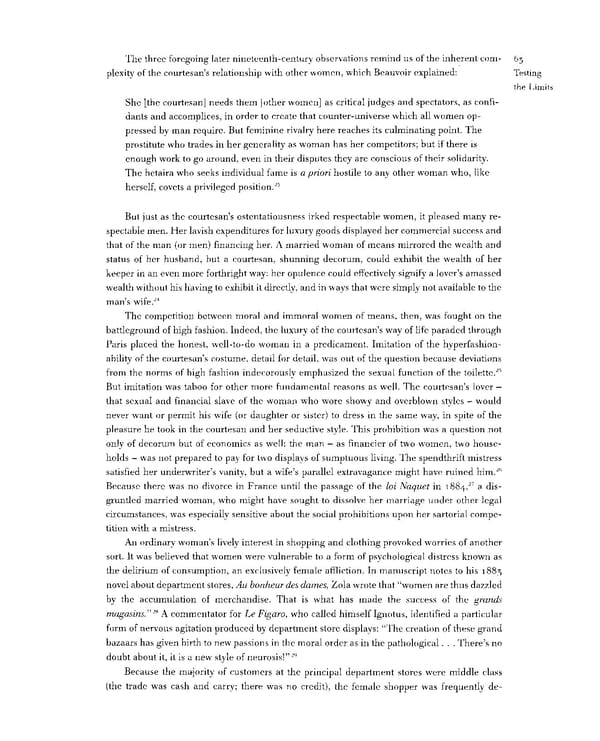The three foregoing later nineteenth-century observations remind us of the inherent com- 63 plexity of the courtesan's relationship with other women, which Beauvoir explained: Testing the Limits She [the courtesan] needs them [other women] as critical judges and spectators, as confi- dants and accomplices, in order to create that counter-universe which all women op- pressed by man require. But feminine rivalry here reaches its culminating point. The prostitute who trades in her generality as woman has her competitors; but if there is enough work to go around, even in their disputes they are conscious of their solidarity. The hetaira who seeks individual fame is a priori hostile to any other woman who, like herself, covets a privileged position.23 But just as the courtesan's ostentatiousness irked respectable women, it pleased many re- spectable men. Her lavish expenditures for luxury goods displayed her commercial success and that of the man (or men) financing her. A married woman of means mirrored the wealth and status of her husband, but a courtesan, shunning decorum, could exhibit the wealth of her keeper in an even more forthright way: her opulence could effectively signify a lover's amassed wealth without his having to exhibit it directly, and in ways that were simply not available to the 24 man's wife. The competition between moral and immoral women of means, then, was fought on the battleground of high fashion. Indeed, the luxury of the courtesan's way of life paraded through Paris placed the honest, well-to-do woman in a predicament. Imitation of the hyperfashion- ability of the courtesan's costume, detail for detail, was out of the question because deviations 25 from the norms of high fashion indecorously emphasized the sexual function of the toilette. But imitation was taboo for other more fundamental reasons as well. The courtesan's lover - that sexual and financial slave of the woman who wore showy and overblown styles — would never want or permit his wife (or daughter or sister) to dress in the same way, in spite of the pleasure he took in the courtesan and her seductive style. This prohibition was a question not only of decorum but of economics as well: the man — as financier of two women, two house- holds — was not prepared to pay for two displays of sumptuous living. The spendthrift mistress 26 satisfied her underwriter's vanity, but a wife's parallel extravagance might have ruined him. 27 Because there was no divorce in France until the passage of the loi Naquet in i884, a dis- gruntled married woman, who might have sought to dissolve her marriage under other legal circumstances, was especially sensitive about the social prohibitions upon her sartorial compe- tition with a mistress. An ordinary woman's lively interest in shopping and clothing provoked worries of another sort. It was believed that women were vulnerable to a form of psychological distress known as the delirium of consumption, an exclusively female affliction. In manuscript notes to his 1883 novel about department stores, Au bonheur des dames, Zola wrote that "women are thus dazzled by the accumulation of merchandise. That is what has made the success of the grands 28 magasins." A commentator for Le Figaro, who called himself Ignotus, identified a particular form of nervous agitation produced by department store displays: "The creation of these grand bazaars has given birth to new passions in the moral order as in the pathological. . . There's no doubt about it, it is a new style of neurosis!"29 Because the majority of customers at the principal department stores were middle class (the trade was cash and carry; there was no credit), the female shopper was frequently de-
 Prostitution & Impressionists Page 83 Page 85
Prostitution & Impressionists Page 83 Page 85